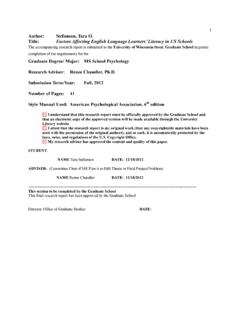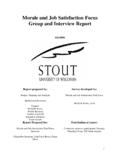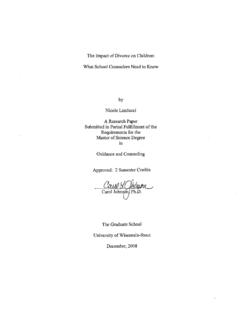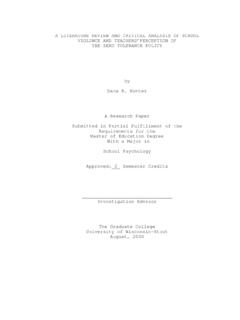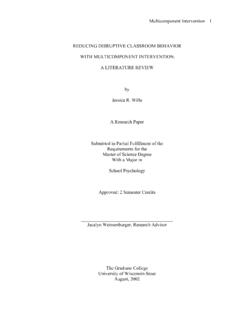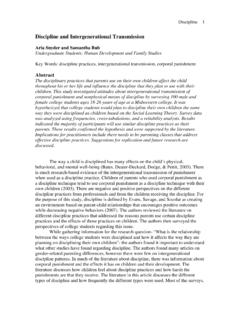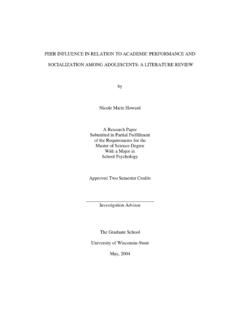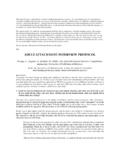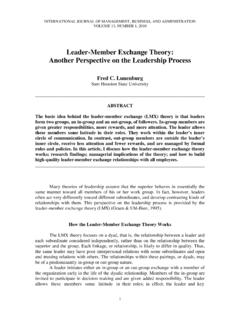Transcription of REASONS GIVEN FOR EMPLOYEE TURNOVER IN A …
1 REASONS GIVEN FOR EMPLOYEE TURNOVER IN A FULL PRICED DEPARTMENT STORE by Jason H. Hammerberg A Research Paper Submitted in Partial Fulfillment of the Requirements for the Master of Science Degree With a Major in Home Economics: Apparel Design, Manufacturing and Retailing Approved: 2 Semester Credits _____ Tena K. Cochran, Chair The Graduate School University of Wisconsin-Stout May, 2002 The Graduate School University of Wisconsin-Stout Menomonie, WI 54751 ABSTRACT Hammerberg, Jason H. REASONS GIVEN for EMPLOYEE TURNOVER in a Full Priced Department Store Home Economics Dr. Tena Cochran 5/2002 65pp Publication Manual of the American Psychological Association (4th ed) EMPLOYEE TURNOVER in the retail workplace has become an important area of research from both a theoretical and a practical standpoint.
2 It is important from a theoretical perspective, in understanding how the underlying causes of TURNOVER can provide insights into how to control the growing problem and where a retailer's specific TURNOVER problems lie. However, from a practical standpoint, learning how to minimize the TURNOVER of skilled employees is crucial from the business expense side. Retailers in the twenty-first century must be able to keep knowledgeable and experienced employees working in their organization. This problem is even more critical in today's retail world considering unemployment rates are hovering near a 30-year low. This study examined 1190 EMPLOYEE exit interviews from a chain of fifty-three department stores to analyze the REASONS GIVEN for leaving the organization.
3 The 41 different REASONS for leaving the organization were organized into categories based on similarities found. Significant differences were found in the REASONS GIVEN for termination based on employment status and length of employment. Full time and part time employees most often left due to job-related REASONS . Hourly employees most often left due to non-job related REASONS . Exiting employees who had worked in the department store three months or less most frequently left without notice ( ), while exiting employees who had worked 12 months or more most frequently left due to job-related REASONS . No significant differences were found in the REASONS GIVEN for termination by males and females. The findings of this research can be used in the development of appropriate programs to reduce the level of EMPLOYEE TURNOVER within retail organizations.
4 ACKNOWLEDGEMENTS I would like to thank my family for contributing to my life as a whole and supporting my decisions along the way. I would especially like to thank my father who always pushed me to get a college education. His constant reminders of college have been in my mind since I was a child. His pursuit of a Masters degree was a great influence in my life and has shown through in the completion of my Masters degree. I would also like to thank Dr. Tena Cochran. She has been spent several hours and much of her personal time for the completion of my research paper. Without her knowledge and expertise this paper would not have been accomplished. TABLE OF CONTENTS Table of List of Chapter 1: Chapter 2: Review of Related Chapter 3: Chapter 4: Chapter 5: Summary, Conclusions and LIST OF TABLES Table 1: Type of Information Provided by Exiting Table 2: Exiting Employees by Table 3: Total Termination by EMPLOYEE Table 4: Frequency and Percentage Distribution of Exiting EMPLOYEE by Length of 47 Table 5: Number of Exiting Employees by Store Table 6: Frequency and Percentage of REASONS for Termination by Exiting Table 7: Frequency and Percentage of REASONS for Termination by Table 8.
5 Frequencies and Percentages of REASONS for Termination by Employment Table 9: Collapsed Categories of Individual REASONS for Table 10: Frequency and Percentage Distribution of Reason for Termination by Table 11: Frequency and Percentage Distribution of Reason for Termination of Male and Female Employees by Table 12: Frequency and Percentage Distribution of REASONS for Termination by Employment Table 13: Frequency and Percentage Distribution of Reason for Termination by Length of ..56 - 1 - CHAPTER ONE INTRODUCTION The problem of EMPLOYEE TURNOVER has been one of the most studied topics in retail history (Schwab,1991).
6 EMPLOYEE TURNOVER continues to plague many retailers because there are no clear resolutions to the problem despite years of research. A great deal of the early research literature, especially prior to 1980, focused primarily on the causes of TURNOVER (Mueller & Price, 1989; Price, 1977; Staw, 1980). The findings of these researchers revealed some of the major causes of retail TURNOVER and made use of a variety of definitions for EMPLOYEE TURNOVER , which are delineated in the following paragraphs. The exact definition of what constitutes EMPLOYEE TURNOVER varies from one research study to another. Price (1977) defines TURNOVER as the degree of individual movement across the membership boundaries of a social system ( ). When a group of employees is considered a social system, this definition would apply and includes accession and the hiring of new employees within an organization.
7 Macy & Mirvis (1976) viewed TURNOVER as any departure beyond organizational boundaries (p. 224). Although these definitions vary somewhat, each was appropriate in the context of the specific research study in which it was used. For this study, Mobley s (1982) definition most accurately reflects the conceptual position of the research. Mobley stated that TURNOVER is the cessation of membership in - 2 -an organization by an individual who received monetary compensation from the organization (p.)
8 10). GIVEN corporate America s increased use of temporary workers, this definition insures that those contracted for a temporary period, often through an outside agency, would not be considered. Also excluded from consideration are those who transfer within the same organization. A final salient feature of Mobley s definition is the inclusion of all forms of cessation from the organization, which would most typically include an interruption such as a layoff, disability or permanent discontinuation. Previous research findings indicated that some causes of EMPLOYEE TURNOVER are job-related factors that are somewhat within the direct control of the employer. Examples of such factors would be dissatisfaction with working conditions, supervising conflicts, scheduling conflicts or salary discrepancies.
9 Understanding the causes of job-related TURNOVER is crucial in being able to identify problems within an organization that might be controlled by the employer. Corrective steps taken in this area included training programs for supervisors, clarification of the EMPLOYEE 's purpose or role and identifying scheduling solutions (Ulschak & Snowantle, 1992). In contrast, non job-related causes of EMPLOYEE TURNOVER are generally out of the employer s control. Non job-related causes of EMPLOYEE TURNOVER are those things in the EMPLOYEE 's personal life that impact their performance in the workplace. Examples of these would be relocation, family problems and chemical abuse. Although these causes are not directly within the employer s control, some organizations have sponsored responsive programs for the non job-related category such as EMPLOYEE assistance - 3 -programs and stress management training that better prepared employees to deal with personal issues that impact their work performance.
10 More recently, the retail industry has been alert to the changing needs of employees and has modified and expanded position offerings to address these needs (Ulschak & Snowantle, 1992). The dynamics have changed the way positions are developed and will evolve over an EMPLOYEE s tenure with the organization. Additional insight into the causes of EMPLOYEE TURNOVER within an organization helps to focus attention on finding real solutions to a problem that will not disappear. Purpose of the Study The purpose of the study was to investigate the causes of EMPLOYEE TURNOVER in a chain of 53 full-price department stores located in the midwestern portion of the United States. The findings of such an investigation would be useful in refining personnel practices and hopefully decreasing the incidence of job-related EMPLOYEE TURNOVER in the organization.


